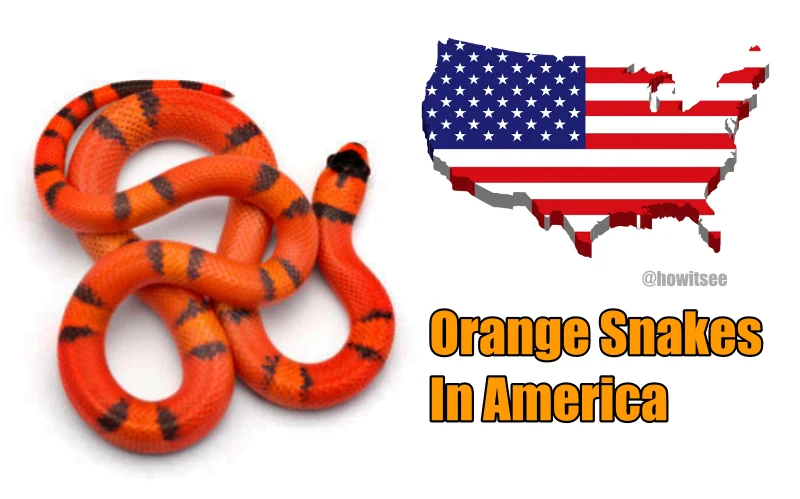You might see the beauty of nature and find peace in it. But when you see a beautiful snake, you might get scared but be amazed by its beautiful color. There are many snakes in the world that have distinct features and colors. Some of them are venomous, while others are non-venomous. Today we are going to look at a specific kind of snake. We are going to look at 10 uncommon orange snakes in America.
10 Uncommon Orange Snakes in America
1. Scarlet snake

| Scientific name | Cemophora coccinea |
| Diet | Eggs of other snakes and lizards |
| Size | 36-51 cm |
| Location | the coastal regions of the southeastern United States, from the pine barrens of New Jersey south to Florida and west to Oklahoma |
Scarlet snakes are thin-bodied snakes. Reside in southeastern America. Found in pine flatwoods, dry prairies, hardwood hammocks, and sandhills.
The scarlet snakes have a whitish-grey dorsal ground color and long red, orange, or yellow blotches bordered by black down the entire body.
These secretive snakes are primarily burrowers and are found under rocks, logs, and debris. Although they are abundant locally, they are not commonly seen due to their secretive nature. If you see these snakes near you, don’t worry because they are non-venomous.
2. Everglades Rat Snake
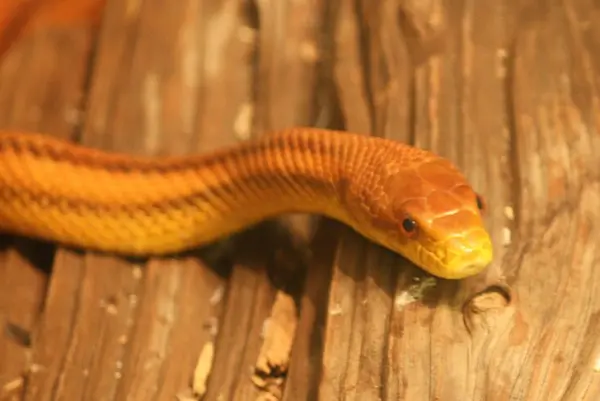
| Scientific name | Elaphe obsoleta rossalleni |
| Diet | Rodents and other small mammals |
| Size | 91-182 cm |
| Location | throughout the farmlands, forests, and wetlands of Florida, particularly in the Everglades National Park |
Another beautiful orange snake in America is the Everglades Rat Snake. Everglades rat snakes are non-venomous snakes that are found in the Florida Everglades. They are typically active during the day and hunt for prey at night.
They are excellent climbers and swimmers, and can often be found up in trees or in the water. When alarmed, they will vibrate their tail and expel a musk to scare off predators.
Everglades rat snakes have been known to hybridize with the gray rat snake in the panhandle west of the Apalachicola River.
3. Ground Snake
| Scientific name | Sonora semiannulata |
| Diet | Rodents, bats, and small birds |
| Size | 20-50 cm |
| Location | Southwestern United States, in Arizona, Nevada, California, Colorado, Kansas, Missouri, New Mexico, Oklahoma, Oregon, Texas, and Utah, as well as northern Mexico, in Chihuahua, Coahuila, Durango, Nuevo León, and Sonora |
This snake has a variety of colors. They have horizontal black stripes with some shades of orange, red, and brown. These snakes like to reside in rocky habitats. They like dry and sandy areas so that they can burrow under the sand.
These snakes are shy and non-venomous. Great Plains ground snakes can’t be found easily. These snakes are one of the largest communities of orange snakes in America. Also known as western ground snakes.
4. Eastern Hog-Nosed Snake
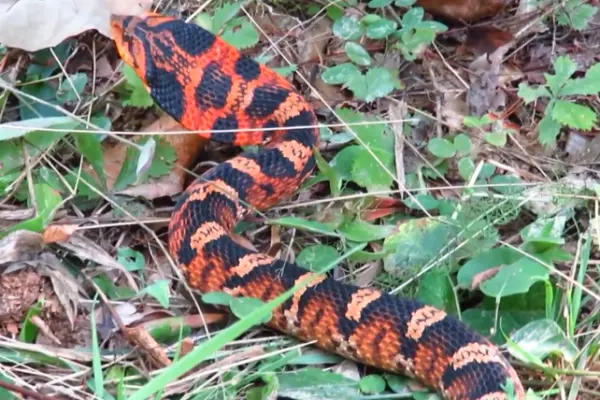
| Scientific name | Heterodon platirhinos |
| Diet | Frogs, small mammals, eggs of birds, and insects |
| Size | 51-84 cm |
| Location | Eastern North America from southern Canada, the Great Lakes region, and New England south to Florida |
This uncommon orange snake in America is active during the daytime. This snake has an extremely varied color pattern. They can be found in yellow, olive, orange, black, brown, and many other colors.
Their color mostly depends on the region where they reside. This snake has blotches on the back of an irregular snake.
One of the interesting facts is that they lay eggs in the sand. Found in sandhills, high mountains, woodlands, and cultivated fields. This mildly venomous snake is not dangerous to humans.
5. Corn Snake
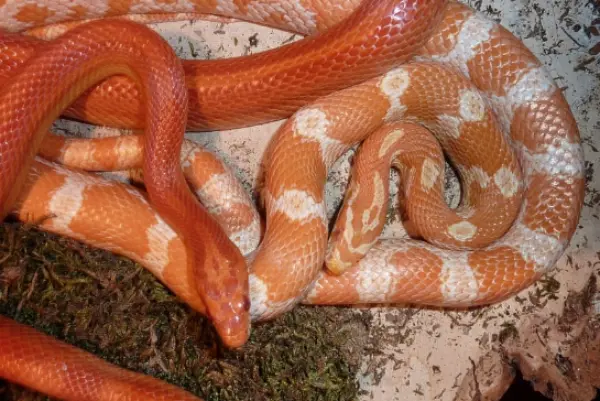
| Scientific name | Pantherophis guttatus |
| Diet | Rats, mice, and quails |
| Size | 61-182 cm |
| Location | Northern, central, and southeastern America |
Corn snakes, a popular pet snake, have orange or orange-brown bodies with red blotches. They are adaptable and prefer habitats like fields, forest openings, and farms. They are excellent climbers and lay eggs in warm, hidden locations.
Corn snakes subdue their prey by constriction and are found in the central and southeastern United States.
They are venomous snakes, often mistaken for copperheads, but are harmless and can control wild rodent pest populations that spread disease or damage crops. They are often found near grain stores, where they prey on rats and mice.
6. Ring-Necked Snake
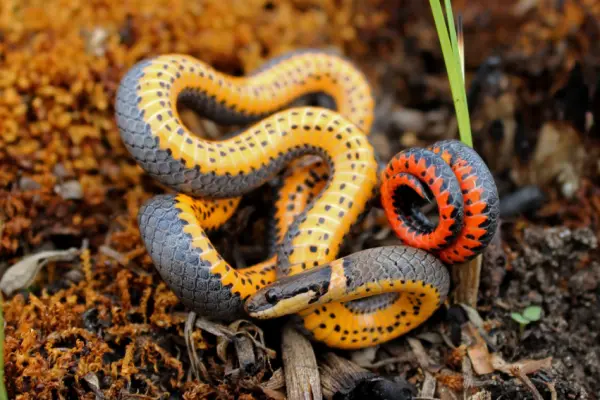
| Scientific name | Diadophis punctatus |
| Diet | Slugs, earthworms, and salamanders |
| Size | 25-38 cm |
| Location | throughout much of the United States, central Mexico, and south-eastern Canada |
Ring-necked Snakes are nocturnal and secretive snakes found in the United States, central Mexico, and southeastern Canada. They are known for their defensive posture, curling their tail to expose their bright orange-red posterior when threatened.
These snakes are harmless to humans but have weak venom to subdue prey. They are nocturnal and prefer areas with vegetation for hiding.
7. Pine Wood Snake
| Scientific name | Rhadinaea flavilata |
| Diet | Small frogs, salamanders, and small lizards |
| Size | 25-33 cm |
| Location | coastal North Carolina and South Carolina, most of peninsular Florida, and small portions of Georgia, Alabama, and Louisiana |
Also known as a brown-headed snake or a yellow-lipped snake. They have dark orange, reddish brown, and yellowish color. The head of this snake is darker than the whole body.
They have a yellowish color over their upper lips. Mostly, found in pine, woodland, and hardwood forests. They have mild venomous potential but can’t be dangerous.
8. Red-Bellied Snake
| Scientific name | Storeria occipitomaculata |
| Diet | Snails, insects, slugs, and earthworms |
| Size | 20-40 cm |
| Location | throughout the eastern US, but are absent from peninsular Florida |
The red-bellied snake is a small woodland species. The snake has a small, thin body. They had dark black and brown heads. Their belly can be orange, yellow, or bluish-gray. Its bright orange underbelly makes it a suitable habitat for this non-venomous snake.
Found in warm habitats, it inhabits abandoned ant mounts, which absorb solar radiation and provide a comfortable home. The snake has large eyes and is nocturnal, consuming slugs and earthworms. It is a non-venomous and non-aggressive species, making it a popular choice for its habitats.
9. Milk Snake
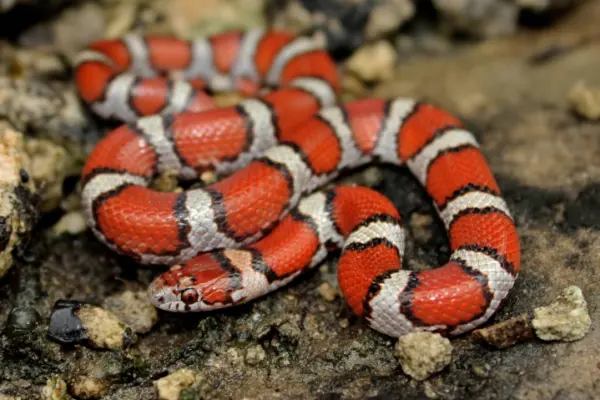
| Scientific name | Lampropeltis triangulum |
| Diet | Eggs of birds, frogs, fish, slugs, and other small creatures |
| Size | 36-183 cm |
| Location | throughout the eastern United States, into southern Canada, and south into Mexico and Central America |
Milk snakes are the species of king snakes. They like to live in forest regions. Also, found in farmlands, sandy dunes, rocky slopes, prairies, and swamps. These snakes hibernate in drier habitats during the winter and return to moist habitats in the summer.
They vary in size, with males being larger than females. Milk snakes have shiny scales with bands of white-black-red or red-black-yellow, and some have red or orange patches.
10. Arizona Mountain Kingsnake
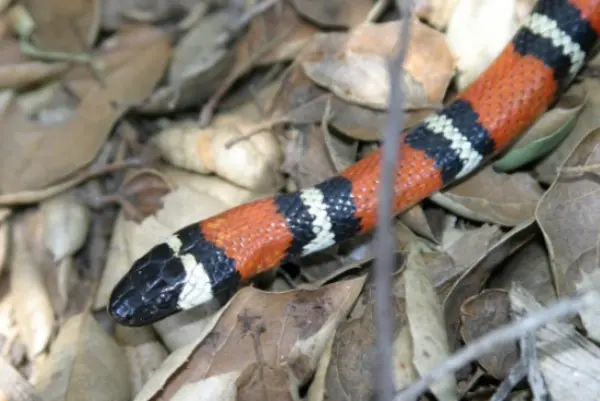
| Scientific name | Lampropeltis pyromelena |
| Diet | Rodents, lizards, birds, and their eggs |
| Size | 91 cm |
| Location | east-central Nevada, central and western Utah, Arizona, and southwestern New Mexico in the United States, to eastern Sonora and western Chihuahua, Mexico |
This snake has red, orange, and white colors with black stripes. The color of this snake acts as a defense against predators. They can live in any habitat.
Easily found near rivers, oak forests, and rocky mountains. This is a non-venomous snake.
11. Mud snake
| Scientific name | Farancia abacura |
| Diet | Slamanders and other small snakes |
| Size | 100-140 cm |
| Location | Alabama, Arkansas, Florida, Georgia, Illinois, Kentucky, Louisiana, Mississippi, Missouri, North Carolina, Oklahoma, South Carolina, Tennessee, Texas, and Virginia |
The mud snake is a nonvenomous, semiaquatic, colubrid snake native to the southeastern United States.
The species is sexually dimorphic, with females being larger than males. The upperside is glossy black, while the underside is red and black.
The mud snake has a cylindrical body with a terminal spine and a short tail with a terminal spine. Its head scalation is distinctive, with one internasal scale, no preocular scale, and one anterior temporal scale.
12. Red belied snake
| Scientific name | Storeria occipitomaculata |
| Diet | Slugs |
| Size | 10-25 cm |
| Location | North America |
Another orange snakes species is Storeria occipitomaculata, also known as the redbelly snake or red-bellied snake, is a harmless snake native to North America.
It measures 10-25 cm in length and has a bright red or orange underbelly. The species preys primarily on slugs and has slender, distally curved teeth for better catch.
Its dorsal color ranges from orange to gray, black, or brown, and many individuals have a light brown ring behind their head.
13. Worm snake
| Scientific name | Carphophis |
| Diet | Small insects like earth worm |
| Size | ~35cm |
| Location | America |
Carphophis is a genus of small colubrid snakes native to the United States, consisting of two species and two subspecies.
Worm snakes are small snakes, 35 cm or less in length, with dark brown uppersides and lighter-colored undersides.
They are cylindrical, unpatterned, pointed, and have small black eyes. Worm snakes are not venomous and eat mostly earthworms and other annelids, as well as soft-bodied insects and invertebrate prey.
Conclusion
These are some of the orange snakes found in America. But these are uncommon and can’t be seen easily around you. Some of these snakes are poisonous and some are not, but all of them are non-dangerous to humans.
FAQs:
Q: Are Scarlet Snakes venomous?
Ans: No, Scarlet Snakes are non-venomous and are primarily burrowers found in southeastern America.
Q: What is the distinctive behavior of Everglades Rat Snakes when alarmed?
Ans: Everglades Rat Snakes vibrate their tail and expel a musk to scare off predators.
Q: Do Ground Snakes prefer rocky habitats or sandy areas?
Ans: Ground Snakes prefer rocky habitats and dry, sandy areas for burrowing under the sand.
Q: What is the interesting fact about Eastern Hog-Nosed Snakes?
Ans: Eastern Hog-Nosed Snakes lay eggs in the sand and exhibit a varied color pattern.
Q: Is the Red-Bellied Snake aggressive and venomous?
Ans: No, the Red-Bellied Snake is non-aggressive, non-venomous, and known for its bright orange underbelly.
Also Read:

As a content writer, I like to write about different niches. I have a curiosity about nature and animals. And like to learn about them. Through my writing, I like to share my experience and knowledge with you. I hope you are enjoying it too.
